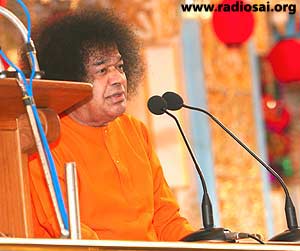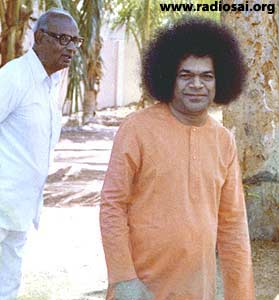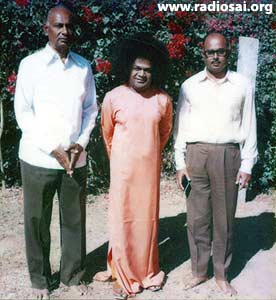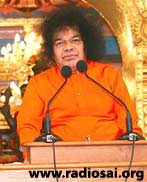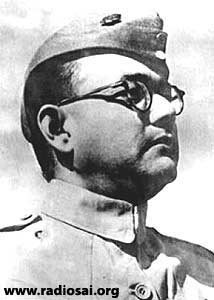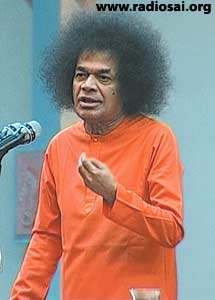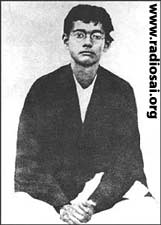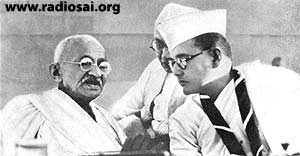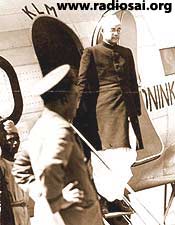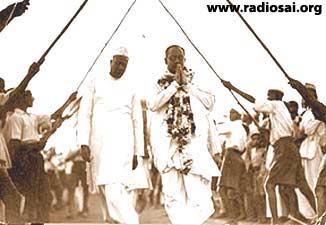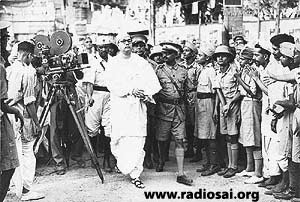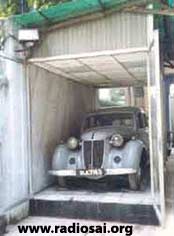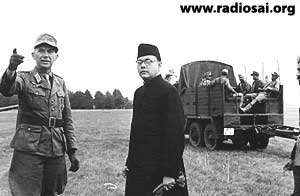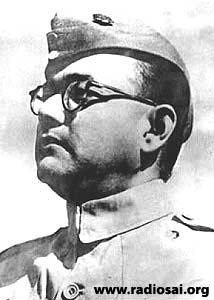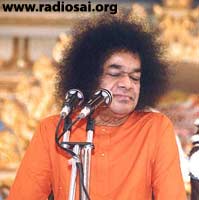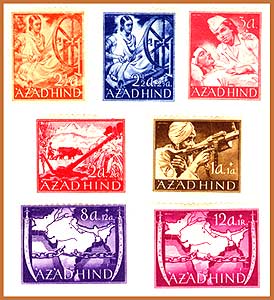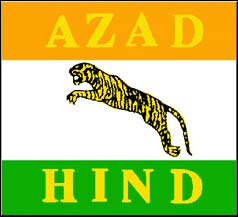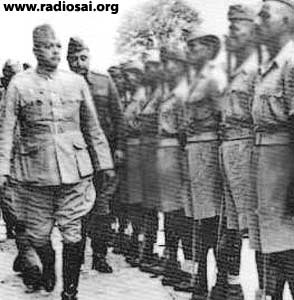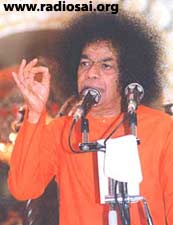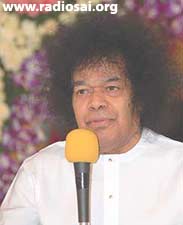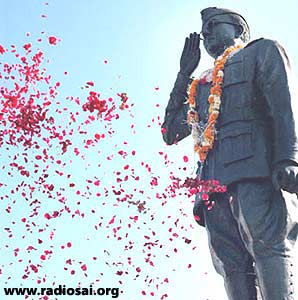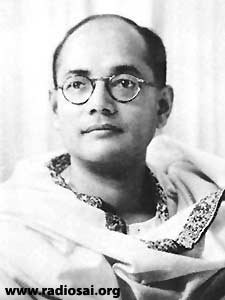 |
 |
 |
Volume
6 - Issue 01
JANUARY 2008 |
India's Independence Day falls on August 15 and Republic Day on January 26. Traditionally, there are no celebrations of these days in the Ashram. Events are restricted to the College Campus, where there is a brief flag-hoisting ceremony followed by a brief speech by the Vice Chancellor. It is all over in about 30 minutes, after which the students rush to the Mandir for Darshan. In the previous year (2007) too, which was the 60th year of Indian Independence, it was no different. However, in the afternoon, in a surprise departure from tradition, Swami asked a few elders to speak on Independence. Understandably, all speakers, conscious of the spiritual nature of the assembly, spoke, after a few references to India's Independence and what it really meant, on the independence of the mind from desires.
If one looks at the history of Indian Freedom Movement, after Mahatma Gandhi, the name that stands out is of Netaji Subhas Chandra Bose. His contribution is no less than those of Mahatma Gandhi and Jawaharlal Nehru, who have been given much of the credit for the successful culmination of India's freedom struggle. It is unfortunate that Netaji has been denied his rightful place in the annals of Indian history and remains largely forgotten. It is more than 60 years since India's Independence, and it is only pertinent that Netaji's remarkable and stirring deeds need to be brought to light in the proper perspective.
An Impassioned Leader
The British rulers acknowledged with serious concern Netaji as the most dynamic and influential political leader in all sections and religious groups of the country. They saw how Netaji's ideas always inspired young idealists to fight more strongly for freedom and saw in this firebrand, charismatic leader a fearsome adversary. Netaji's popularity cut across religious lines. Muslims acknowledged and appreciated the leading role played by Netaji. Even Mohamed Ali Jinnah, who is acknowledged by all as the Father of Pakistan, had so much trust and regard for Netaji that he was willing to give up his idea of a religiously divided India, if Netaji led the nation. Muslim leaders of India's eastern states echoed the same sentiment during the thirties. The revival of INA (Indian National Army) by Netaji shook the confidence of the British regarding the loyalty of the British Indian Soldiers in the Army on whom the British Rule depended in India. The apprehension was strengthened in 1946 when there was a mutiny by the British Indian Navy in Mumbai. The British saw the writing on the wall. Their efforts were now directed towards an honourable withdrawal. When historian Dr Mazumdar spoke to the then Prime Minister of Britain, Lord Clement Atlee on Britain’s decision to grant independence to India, he says, "In his reply Atlee cited among several reasons, the principal among them being the erosion of loyalty to the British Crown among the Indian Army and Navy personnel as a result of the military activities of Netaji". Subhas Chandra Bose was born of 23 Jan 1897 to Srimati Prabhabati Devi and Janakinath Bose, a prominent advocate of Cuttack, who later became a member of the Bengal Legislative Council. He was later awarded the title of Rai Bahadur by the British. On account of the anti- Indian policies of the British rulers, Janakinath returned the title and also resigned from the post of Public Prosecutor.
Excelling in Education
Subhas was the ninth among fourteen siblings and was a brilliant scholar. After matriculation from Ravenshaw Collegiate School, he joined the prestigious Presidency College, Calcutta. His stay was short lived as he could not tolerate the derogatory remarks of Professor Oaten against India and Indians. As a result the Professor had him expelled from the college and rusticated from the Calcutta University in 1916. On the intervention of Sir Ashutosh Mukherjee, Subhash gained admission in the Scottish Church College from where he graduated with a first class in philosophy in 1919, thus emulating his idol, Narendra Nath Dutt (Swami Vivekananda) and left for England to appear in the ICS examination. In 1920 he passed the examination with the highest marks in English and 4th overall. He joined Cambridge University and obtained his Tripos in 1921. He joined the ICS but being a firebrand nationalist, refused to continue and resigned. His Political Career Shines
He returned to India, being deeply disturbed by the Jallianwala Bagh massacre. He met Mahatma Gandhi and on his advice, met Deshbandhu Chittaranjan Das (CR), who remained his political Guru till he passed away in 1925. When CR Das was Mayor of Calcutta, Netaji was his CEO. His nationalist fervour drew the wrath of the British and he was arrested and deported to Mandalay, Burma. He was released in 1927 and in 1929 he was elected as President of All India Trade Union Congress. In 1930 he was elected Mayor of Calcutta. He greatly admired Gandhiji and took part in the Salt Satyagraha when he was arrested. After his release, he publicly denounced the Gandhi-lrwin pact and was arrested again. He was released on health grounds and went to Europe for treatment. While there he established contacts with various European nations to elicit their sympathy and support for India's Freedom struggle. He met Mussolini in Italy, Felder in Germany, D. Valera in Ireland and Romain Rolland in France.
Netaji returned to India defying government orders prohibiting his entry into India and was arrested. He was released on account of the overwhelming victory of the Congress in the 1937 Elections. In 1938, at Haripura Congress Session he was elected as President of the Indian National Congress and elected again in 1939 defeating Dr Pattabhi Sitaramayya who was the Congress nominee. He brought a resolution to give 6 months time to the British to hand over India to Indians, or face a revolt. This was strongly opposed by Gandhiji.
The result was that Netaji resigned within a few months and formed a progressive group known as the Forward Bloc within Congress. Netaji's stand was that there could be no compromise with the British on the issue of full independence and that on no account should the country be partitioned. Although their strategies were diametrically opposite, Gandhiji and Netaji had the highest regard for each other. Both Netaji and Nehru were identified with the Left Wing of the Congress Party, well to the Left of other respected leaders like C Rajagopalachari, Vallabhbhai Patel and Rajendra Prasad. Netaji was firmly of the view that a more direct and militant approach was required to gain independence. Not for him, the peaceful passive non-cooperation movement of Gandhiji and of Congress. At this point of time the British perceived Netaji as a bigger threat than Gandhiji. War Protest In September 1939, World War II broke out and as apprehended by Netaji, India was declared as a warring state (on behalf of the British) by the Viceroy, without consulting the Indian leaders. The Congress government in seven major states resigned in protest. Netaji now started a mass movement against using India's resources and men. To him it made no sense to make Indians shed their blood for the sake of colonial imperial nations. There was a tremendous response to his call and the British promptly imprisoned him. He went on hunger strike and on the 11th day, after his health deteriorated, he was released from prison and put under house arrest. The British were afraid that there would be violent reactions all over the country should something happen to Netaji in prison. Because of his outspoken anti-British stance, he was jailed 11 times between 1920 and 1941 for periods varying between 6 months and 3 years. By this time it had become increasingly clear to him that he could not achieve anything worthwhile by remaining in India. That would bring him in direct confrontation with Gandhiji whom he loved and greatly admired. It would suit the British and harm India's cause for freedom. Scouting for Support Abroad
On 17 January, 1941, he disappeared from house arrest. His nephew, Sisir Bose, drove him out of Calcutta in great secrecy. Thus began a hazardous and arduous journey by foot, train and car to Kabul, with the support of the Kirty Party affiliated to the Communist Party of India. His plan was to travel to Russia and enlist Stalin's help to drive out the British from India, but unknown to Netaji, the British had secretly entered into a strategic non-aggression pact with Russia. As a result the Russian Embassy at Kabul gave a cold shoulder to Netaji but he still decided to try to enlist Russian help. Netaji's journey from Peshawar to Kabul was an epic in itself. Only his iron will and the burning desire to free India from foreign rule, enabled him to endure the rugged mountainous route, great risks of capture and freezing weather. Accompanied by Bhagatram, he reached Kabul. Armed with an assumed identity and passport from the Italian Legation in Kabul, in the name of Signor Orlando Mazzito, a supposed wireless operator, and accompanied by Dr Voelger, Netaji left Kabul for Samarkand on 18 March 1941, from where they boarded a train for Moscow on 20 March. Disappointed with the lack of response from Stalin, Netaji decided to leave for Berlin. Although, he despised Nazism, he was prepared to make friends with the devil if that would help his cause. In League with the Axis Powers Contact with German leaders was not easy, busy as they were with the conduct of the War, in spite of being well aware of Netaji's well known anti-British stand. Netaji's burning desire, his endless patience and untiring perseverance succeeded in the end and he was able to interact with Adam Von Trott Zu Solz (head of the German Eastern Affairs) and his deputy Alexander Werth. Later Werth wrote, "Very soon we felt the strength of his will power, the honesty of his intentions and the inexorability of his personal dedication to India's cause, we could not help being influenced by his ideas and wishes". On his initiative, Netaji obtained the release of all Indian prisoners from POW camps and started the Free India Centre, Azad Hind Radio Centre in Oct 1941 and finally the Indian Legion (Azad Hind Fauj), comprising enthusiastic Indian students, political activitists and Indian prisoners captured by Rommel from various battles in Africa. It was difficult to change the mindset of the Indian POWs but Netaji was not to be stopped.
Netaji met Hitler on 26 May 1942 to plead the urgency of his case. The latter, preoccupied by the German offensive towards Leningrad, was a little hesitant and wanted to know exactly what kind of 'political concept' Netaji had in mind. Extremely annoyed at this, he asked von Trott to tell 'His Excellency' that he had been in politics all his life and did not need advice from any side. Nobody else would have dared to tick off Hitler at the height of his powers, but this was a man of steel, who had no fear. In the meanwhile, Japanese forces had gained control ever the entire area from the Sea of Japan to Bay of Bengal. By May 1942, Hongkong, Singapore, Manila, Penang and Rangoon had fallen to the Japanese. Another Indian revolutionary, Rash Behari Bose persuaded and obtained from the Japanese Government, wholehearted support for the fight against the British Raj. Netaji, who was still trying to persuade Hitler to support an Indian Government in exile, was greatly encouraged by the latest development in Japan. German motives and intentions with relation to India were complex. While the German foreign office wanted to support the Indian revolutionary, Hitler's personal belief was that the Aryan British had the right to rule over the unfit Indian masses. A Hazardous Japanese Voyage The developments in Japan convinced Netaji that he could play a much more active role from the soil of Asia rather than spending agonizingly prolonged periods staying in Berlin. Time was running out. He had to be where the action was. He was able to convince Germany and Italy to help him reach Japan. After long and complicated discussions with the Italian and the Japanese Embassies in Berlin and Rome and German authorities, the following plan was drawn up. Netaji, accompanied by one friend, would be taken by a German submarine by way of the English Channel, Bay of Biscay, West Africa, around South Africa to the South of Madagascar, where he would be transferred to a Japanese submarine, which would take him to the nearest base in East Asia. Eventually on the night of 7 Feb 1943, Netaji and his deputy, Nambiar, German State Secretary, Keppler and Alexander Werth, from the Special India Division, took Netaji and his companion Abid Hassan to Kiel, to where a submarine was waiting. Thus began another epic journey of great risk and danger undertaken by Netaji. Two and a half months later on 26 Apr 1943, visual contact was made by the two submarines. As the sea was pretty rough, the two submarines travelled further North East. On 28 April 1943, despite inclement weather, Netaji and Abid Hassan were transferred from the German submarine to the Japanese by means of a rubber boat. On 6 May 1943 they landed at Saban, not Penang as originally intended. He was welcomed by Yamamoto, the Japanese Military Attache at Berlin Embassy, who had reached earlier. Finally on 16 May 1943 Netaji reached Tokyo. Enlisting Help from the Japanese
Thus the stage was set for Netaji to emerge as the leader of the independence movement in East Asia. He met Prime Minister Tojo on 10 June 1943. In "The Springing Tiger" (p l77-178), Hugh Toye observed "For most the personality of the man was overwhelming, there was great genius of enthusiasm, of inspiration. Men found that when they were with him only the cause mattered, they saw only through his eyes, through the thoughts he gave them, could deny him nothing". General Tojo was no exception. He was charmed as Netaji stood before him and spoke of his iron will and determination to secure India's independence from the British. He saw fire in the man's belly, hunger for freedom in his eye and nothing in his words but great devotion to his motherland. Meanwhile in India, following the failure of the Cripps mission, Congress became increasingly more impatient and was not prepared to wait till the end of the war for Independence. Even Gandhiji started to look a little moved by Netaji's activities in Europe and Jayprakash Narain openly supported Netaji's armed revolution. Netaji's cry "Quit India" became the slogan and his call "Do or Die" became the motto. In August 1942 most of the important political leaders were imprisoned by the British. This was the kind of electric energy Netaji radiated from long distance. R Coupland ("Indian Politics" p-268) wrote, "The Revolutionaries of extreme left, specially in Bengal, were still ready to take orders from Mr Subhash Chandra Bose, even if they came by radio from Berlin ". The British retaliated by disbanding the provincial Congress Committee of Bengal on 10 August, 1942. Maulana Abul Kalam Azad, president of the Congress from 1939 to 1946, states in his book "India Wins Freedom" (published posthumously), that Gandhiji had not approved many actions of Netaji, but the courage shown by him in escaping into Germany and the resourcefulness displayed there by him in mobilizing a campaign for liberating India, unconsciously coloured Gandhiji's views about the whole situation.
This is reflected in the launching of the Quit India Movement on 8 August 1942, which echoed Netaji's war cry "Do or Die", a slogan not consistent with the policy of pacifism. After the imprisonment of the Congress leaders, the movement quickly deteriorated into acts of defiance, anarchy and mayhem at the local level. The movement created alarm amongst the British and significantly hindered the Allied war effort. In Tokyo, Netaji met Prime Minister, Gen Tojo again on 14 June, who agreed to extend every possible support for the cause of Indian independence. He then left for Singapore. When he arrived on 2 July, he received a tumultuous welcome there from soldiers and civilians alike. Hugh Toye writes, "His personal enthusiasm, his vitality, his authority and his world view won him the real allegiance of Indians in East Asia". On 4 July 43 a reception was held in his honour, during which Rash Behari Bose transferred the mantle of the Indian Independence League to Netaji. On 25 August 1943 he was formally appointed the Commander-in-Chief of the INA. On 23 October 1943 Japan announced its official recognition of the Provisional Government of India of Subhas Chandra Bose. Recognition from the German Government followed on 29 October 1943 and from Italy on 9 November 1943.
The Story of the Indian National Army No story about Netaji would be complete without the exploits of his Azad Hind Fauz (INA). The story of INA began much earlier. By the end of 1941, India had started featuring prominently in the Japanese policies. An organization was set up by the Japanese Government, headed by Major Fujiwara Iwaichi. His initial contact was with Giani Pritam Singh, and after the Malayan invasion, with Capt Mohan Singh. Between the three of them, they started recruiting from amongst those captured by the Japanese in Malaya prior to the fall of Singapore. Thus was born the nucleus of what later came to be known as the Indian National Army.
The volunteers were organized into units and trained under Capt Mohan Singh and worked along with those under Pritam Singh in Malaya and Thailand. Capt Mohan Singh saw action with 1/14 Punjab against Japanese forces at Jitra. Singapore surrendered on 15 February 1942. On the morning of 17 Febuary 1942 some 45,000 Indian POWs gathered at Farrer Park. They were first addressed by Col Hunt of the Malaya Command and then by Maj Fujiwara, who spoke of Japanese intentions of raising a "liberation army". Thereupon he passed on the responsibilities and command to Capt Mohan Singh. The POWs felt that they had been abandoned and handed over like cattle to the Japanese. Nearly half of those present, joined the INA. By late 1942, disillusionment set in and Indian volunteers felt like pawns in the hands of the Japanese. In Dec 42, Capt Mohan Singh and INA leaders ordered the INA to disband. Capt Mohan Singh was arrested and exiled to Pulau Ubin. Between December 1942 and Febuary 1943, Rash Behari Bose tried to keep the ML and INA going but failed. Thousands of INA soldiers returned to POW status again. In a series of meetings with the Japanese, a large number of officers and troops of INA made it known that they would regroup only if Netaji assumed command. Netaji's exploits in Germany had become common knowledge. A policy forming body for the INA was formed consisting of Lt Col Bhonsle, Lt Col Shah Nawaz Khan, Maj P K Sehgal, Maj Habibur Rahman and Lt Col AC Chatterji. The INA is Rejuvenated
Netaji's stirring speech on 5 July 1943 at Singapore on assuming charge of President of ML from Rash Behari Bose, re-ignited the flame of liberation of the motherland from the British. His impact was significant and immediate. A new life had been infused in the INA. Besides POWs local civilians with no military experience, from barristers to plantation workers, joined the INA and doubled its troop strength. An Officers Training School for INA officers and the Azad School of civilian volunteers was set up. A group of 45 young Indians personally chosen by Netaji (known as Tokyo Boys) was sent to Japan's Imperial Military Academy to train as fighter pilots. For the first time, outside USSR, a women's regiment, the Rani of Jhansi Regiment under Capt Lakshmi Sehgal was raised as a combat force. Dr Lakshmi Swaminadhan (as she was then) gave up a prosperous practice as a gynaecologist in Singapore to join the INA. The clarion call of INA was 'Jai Hind' and 'Chalo Delhi'. The preparation for assault moved at a fast pace and the INA HO was moved from Singapore to Rangoon on 7 January 1944. It was decided inter alia, that the only flag to fly over the Indian soil would be the National Tricolour and that any solider, Japanese or Indian, found looting or raping, would be shot at once. A String of Triumphs
The first success of INA came in Arakan's Maya Valley by Maj L S Misra's unit against the 7 Indian Division. Success stories continued. Kohima fell to INA's Subhas Brigade on 8 April 1944 under the command of Col Thakur Singh. Moirang fell to INA on 18 April 1944 when troops under Col Shaukat Malik, raised the National Tricolour. Maj Gen Kiani's troops and Col Shah Nawaz Khan's Subhas Brigade surrounded the British troops in Imphal for 3 months. The success of the INA caused Mountbatten grave concern. Under his directions the 3 rd Indian Division facing the INA at Imphal remained Indian in name only. Twenty four of its battalions had English, Nigerian and Burmese soldiers, because he feared that Indian soldiers would join the INA. The siege of Imphal was to be the turning in the saga of the INA. It was not the British army, but the monsoon, which became the biggest adversary. Logistics became the major problem as B 29 bombers disrupted the lines of supply. INA was left without air cover as Japanese aircraft were diverted elsewhere to combat the air power of America, which entered the War after Pearl Harbour, giving exact INA positions. Outbreaks of malaria and dysentery in the face of lack of medical facilities and supplies took a heavy toll. Netaji was forced by circumstances to issue instructions to INA to withdraw. The extent of loss during the long withdrawal was significant in its impact on the INA. The Axis Surrender Blights the INA Netaji did not give up and the task of rebuilding the INA continued in Burma. They continued to provide stiff resistance to the Allied advance, but the tide turned inexorably. On the Western front on 6 June 1944 Allied forces landed on the beaches of Normandy and the thrust towards Berlin began, just as the thrust towards Rangoon had already started on the Eastern front.
On 7 May 1945 Germany formally surrendered following the death of Hitler. Japan continued, but it was a losing battle. On 7 August 1945 the first atom bomb was dropped on Hiroshima followed by the second bomb on 9 August 1945 on Nagasaki. Inevitably Japan surrendered. Netaji announced in his calm voice, "Japan's surrender is not India's surrender. The INA would not admit defeat." Netaji wanted to stay on in Singapore but under extreme pressure from his cabinet colleagues, decided to leave. He travelled to Saigon and from there to Taiwan and then he disappeared. Nobody believed the story that he died in an air crash. The remnants of the INA were to surrender when the Allied forces captured Burma. The British tried to put Shah Nawaz Khan and other INA officers on trial to set an example, but fears of a violent backlash put paid to their plans. According to Md Muktadir Arif Mozammel, the cause of India's independence was greatly advanced by the spirit of nationalism aroused by the INA. Although the term INA has been used, Netaji loved to call it Azad Hind Fauj. Bose’s Tremendous Legacy Gandhiji and Netaji had great love for each other. Netaji reportedly said, "It will be tragic for me if I succeeded in winning the confidence of the people but failed to win the confidence of India's greatest man (Mahatma Gandhi). Gandhiji wondered in 1945 how Netaji could die when Swaraj was yet to be achieved. This conviction caused much dismay to the British Government. He wrote in the 24-2-1946 issue of 'Harijan' that "Subhash Chandra Bose's patriotism is second to none". When Gandhiji became reconciled to the fact that Netaji had died, he stressed that, "He is living with us in his message and ideals he placed before the world". Shah Nawaz Khan told Gandhiji that Netaji had made it clear to the INA soldiers that in an independent India, they would be expected to serve their country not by means of swords but through non-violence. P N Oak, one of the earliest to join Netaji's INA and had helped organize broadcasts from Azad Hind Radio in Saigon and Singapore, says that Netaji was totally disinterested in worldly pursuits and ambitions. He repeatedly and emphatically declared in his public speeches that if INA succeeded liberating India, he would toss over that freedom to the people and retire into spiritual oblivion. Thus a common belief of political observers that Nehru and Netaji were rival contenders for political leadership, was basically wrong. Netaji had no such ambitions. Whether Nehru perceived Netaji as a threat to his position, remains a moot point.
The stories of the deeds of the INA that became public knowledge during the trials of soldiers of the INA in 1945 were perceived as so inflammatory that the British Government forbade the BBC from broadcasting their story, fearing mass revolts and uprisings. The Naval mutiny in Bombay was followed by another among the ground crew in the Royal Indian Air Force. An army mutiny broke out at Jabalpur during the last week of Feb 1946, which had to be put down with difficulty. The weekly intelligence summary of 25 March 1946 admitted that the Indian Army, Navy and Air Force units could not be relied upon to put down mass revolt. Thus what Netaji and the Azad Hind Fauj failed to achieve directly, was successful posthumously. The trials were carried out in the Red Fort, New Delhi, thus ironically enabling the INA remnants to achieve Netaji's War Cry, "Chalo Delhi." A number of commissions have probed Netaji's disappearance, but nothing has come out of them. On this month of January when he was born a hundred and ten years ago, let us shed a tear and refresh our memory of this great son of India, Netaji Subhas Chandra Bose and his intrepid band of freedom fighters. Dear Reader, did you find this article helpful? Would you like to have articles of this nature on inspiring personalities? Please write to us at h2h@radiosai.org mentioning your name and country. Thank you for your time.
|
|||||||||||||||||||||||||||||||||||||||||||||||||||||||||||||||||||||||||||
Vol 6 Issue 01 - JANUARY 2008
|
Best viewed in Internet Explorer - 1024 x 768 resolution. |

